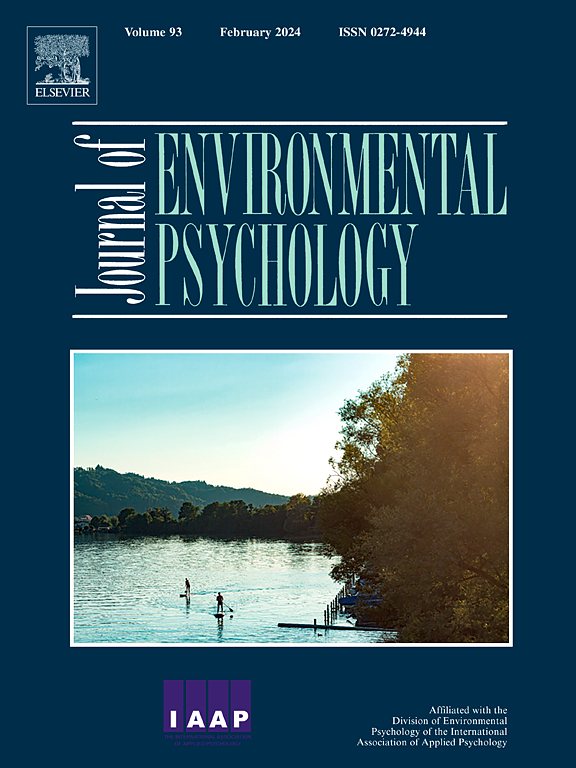接触自然景观可以减轻青少年被社会排斥的不利影响
IF 7
1区 心理学
Q1 ENVIRONMENTAL STUDIES
引用次数: 0
摘要
被排斥是一种社会痛苦和有害的经历,通常在日常生活中遭受。本研究的目的是研究视觉暴露对遭受排斥的青少年可能的恢复作用。我们进行了2(排斥:社会排斥/包容)× 2(环境条件:自然;非自然)× 3(时间:基线;操作;干预)实验。我们在三个不同的时间段测量了积极影响、感知社会能力和注意力。在T0时,测量基线水平;在T1时,诱导排斥反应;T2时,通过自然刺激和非自然刺激诱导恢复。参与者为304名西班牙青少年(年龄= 14.66岁;SD = 1.39)。我们的研究结果表明,在社会排斥条件下,参与者的积极情感和感知社会能力被耗尽,但注意力几乎保持不变。从T1到T2,被排斥者的积极情绪和感知社会能力在接触自然场景后有所提高。注意力的提高与参与者所接触的刺激类型无关,可能是由于学习效应。总之,这些发现表明,视觉自然暴露可能是青少年恢复因社会排斥而减少的资源的潜在积极机制。本文章由计算机程序翻译,如有差异,请以英文原文为准。
Exposure to nature scenes mitigates the adverse effects of adolescents’ social ostracism
Ostracism is a socially painful and detrimental experience commonly suffered in daily life. The objective of this study is to examine the possible restorative effects that visual exposure to nature has on adolescents who suffer from ostracism. We conducted a 2 (Ostracism: social exclusion/inclusion) x 2 (Environmental condition: natural; non-natural) x 3 (Time: baseline; manipulation; intervention) experiment. We measured positive affect, perceived social competence, and attention at three different time periods. At T0, baseline levels were measured; at T1, ostracism was induced; and at T2, restoration was induced via the presentation of natural stimuli and non-natural stimuli. Participants were 304 Spanish adolescents (Mage = 14.66 years; SD = 1.39). Our findings show that participants' positive affect and perceived social competence were depleted in the social exclusion condition but attention remained virtually the same. From T1 to T2, ostracized participants’ positive affect and perceived social competence improved after exposure to nature scenes. Attention improved independently of the kind of stimuli participants were exposed to, probably due to a learning effect. Altogether, these findings suggest that visual nature exposure can be a potential positive mechanism for adolescents to recover diminished resources due to social ostracism.
求助全文
通过发布文献求助,成功后即可免费获取论文全文。
去求助
来源期刊

Journal of Environmental Psychology
Multiple-
CiteScore
10.60
自引率
8.70%
发文量
140
审稿时长
62 days
期刊介绍:
The Journal of Environmental Psychology is the premier journal in the field, serving individuals in a wide range of disciplines who have an interest in the scientific study of the transactions and interrelationships between people and their surroundings (including built, social, natural and virtual environments, the use and abuse of nature and natural resources, and sustainability-related behavior). The journal publishes internationally contributed empirical studies and reviews of research on these topics that advance new insights. As an important forum for the field, the journal publishes some of the most influential papers in the discipline that reflect the scientific development of environmental psychology. Contributions on theoretical, methodological, and practical aspects of all human-environment interactions are welcome, along with innovative or interdisciplinary approaches that have a psychological emphasis. Research areas include: •Psychological and behavioral aspects of people and nature •Cognitive mapping, spatial cognition and wayfinding •Ecological consequences of human actions •Theories of place, place attachment, and place identity •Environmental risks and hazards: perception, behavior, and management •Perception and evaluation of buildings and natural landscapes •Effects of physical and natural settings on human cognition and health •Theories of proenvironmental behavior, norms, attitudes, and personality •Psychology of sustainability and climate change •Psychological aspects of resource management and crises •Social use of space: crowding, privacy, territoriality, personal space •Design of, and experiences related to, the physical aspects of workplaces, schools, residences, public buildings and public space
 求助内容:
求助内容: 应助结果提醒方式:
应助结果提醒方式:


